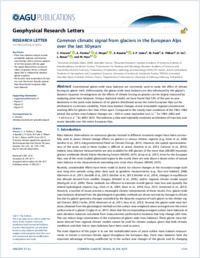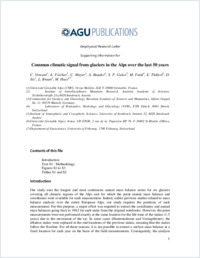Common climatic signal from glaciers in the European Alps over the last 50 years
- Vincent, C. Université Grenoble Alpes, CNRS, Grenoble, France
- Fischer, A. Mountain Research, Austrian Academy of Sciences, Institute of Interdisciplinary, Innsbruck, Austria
- Mayer, C. Commission for Geodesy and Glaciology, Bavarian Academy of Sciences and Humanities, Munich, Germany
- Bauder, Andreas Laboratory of Hydraulics, Hydrology and Glaciology (VAW), ETH Zürich, Switzerland
- Galos, S. P. Institute of Atmospheric and Cryospheric Sciences, University of Innsbruck, Austria
- Funk, Martin Laboratory of Hydraulics, Hydrology and Glaciology (VAW), ETH Zürich, Switzerland
- Thibert, E. IRSTEA, Université Grenoble Alpes, St-Martin d'Hères, France
- Six, D. Université Grenoble Alpes, CNRS, Grenoble, France
- Braun, L. Commission for Geodesy and Glaciology, Bavarian Academy of Sciences and Humanities, Munich, Germany
- Huss, Matthias Laboratory of Hydraulics, Hydrology and Glaciology (VAW), ETH Zürich, Switzerland - Department of Geosciences, University of Fribourg, Switzerland
-
16.02.2017
Published in:
- Geophysical Research Letters. - 2017, vol. 44, no. 3, p. 1376–1383
English
Conventional glacier-wide mass balances are commonly used to study the effect of climate forcing on glacier melt. Unfortunately, the glacier-wide mass balances are also influenced by the glacier's dynamic response. Investigations on the effects of climate forcing on glaciers can be largely improved by analyzing point mass balances. Using a statistical model, we have found that 52% of the year-to-year deviations in the point mass balances of six glaciers distributed across the entire European Alps can be attributed to a common variability. Point mass balance changes reveal remarkable regional consistencies reaching 80% for glaciers less than 10 km apart. Compared to the steady state conditions of the 1962–1982 period, the surface mass balance changes are −0.85 m water equivalent (w.e.) a⁻¹ for 1983–2002 and −1.63 m w.e. a⁻¹ for 2003–2013. This indicates a clear and regionally consistent acceleration of mass loss over recent decades over the entire European Alps.
- Faculty
- Faculté des sciences et de médecine
- Department
- Département de Géosciences
- Language
-
- English
- Classification
- Hydrology
- License
-
License undefined
- Identifiers
-
- RERO DOC 288656
- DOI 10.1002/2016GL072094
- Persistent URL
- https://folia.unifr.ch/unifr/documents/305521
Other files
Statistics
Document views: 155
File downloads:
- pdf: 210
- Supplementary material: 137

